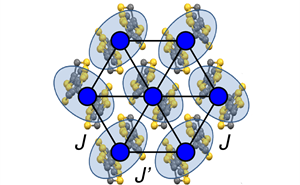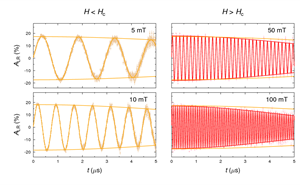The fruit of their five years of work is a unique and detailed map of this rare state of matter known as a ‘quantum spin liquid’. This strange state of matter was proposed to exist in the 1970s but has only recently been confirmed. Until now, there has been very limited information available describing its physical characteristics. By using the extremely sensitive technique of muon spin rotation, the properties of the quantum spin liquid state have been measured over a wider magnetic field range and in considerably greater detail than before.
The research team led by Dr Francis Pratt at the ISIS Neutron and Muon Source at STFC Rutherford Appleton Laboratory includes scientists from ISIS, the University of Oxford and colleagues from Japan. Their work is published this week, 31 March 2011, in the science journal Nature.

The magnetic field - temperature phase diagram for k-(BEDT-TTF)2Cu2(CN)3 obtained from muon spin rotation experiments and including previously reported NMR and thermodynamic measurements. The dominant feature of the phase diagram is the presence of two quantum critical points at the well-separated field values H0 and H1. The boundaries between phases and the critical properties of these phases are obtained from a series of magnetic field scans at constant temperature. The quantum critical (QC) and weakly magnetic regions (WAF) are subdivided on the basis of the behaviour of their characteristic critical parameters, β, η and w as functions of temperature or magnetic field. Credit: Francis Pratt/ISIS/Science and Technology Facilities Council
View full-size image
“This research is fundamental physics of the purest kind,” said Dr Pratt. "The quantum spin liquid state is extremely fascinating and we can imagine that in the future it could be of use in quantum computing and cryptography for the writing and deciphering of coded information. But right now we are only at the start of a very long journey to understand it fully.”
“Since the idea of the quantum spin liquid was first proposed there have been many hundreds of papers published speculating on the properties of quantum spin liquids, but until now there has been very little experimental evidence to compare these ideas with,” said Dr Pratt.
The quantum spin liquid state that has been mapped by the team is found in 70 milligrams of tiny black crystals of the rare layered organic material k-(BEDT-TTF)2Cu2(CN)3 cooled to just a couple of hundredths of a degree above absolute zero. Despite it being extremely difficult to make the tiny plate-like crystals, the material is perfect for these experiments since it is on the border between being an insulator and a metal, a key requirement for the existence of the quantum spin liquid state.
Inside the material, atomic-scale magnetic units (spins) are arranged onto triangular grids. Interactions between the spins produce an extremely large number of similar configurations for the network, with the result that the network never settles into one configuration, even at temperatures approaching absolute zero. This behaviour is completely different to the more familiar magnets found in everyday life where, at some particular temperature, the magnetic units become locked into a particular configuration. Analogy with common liquids like water, where the water molecules are constantly moving around, leads to the name of the state: a quantum spin liquid.

Two-dimensional lattice structure of the dimer layers in k-(BEDT-TTF)2Cu2(CN)3.The molecule abbreviated by BEDT-TTF is bis(ethylenedithio)- tetrathiafulvalene. The isoceles triangles in the grid result in different strengths of the magnetic exchange interactions J and J’, with the ratio J’/J estimated to be close to 0.9. Credit: Francis Pratt/ISIS/Science and Technology Facilities Council
View full-size image
“Mapping out the physical properties to create the phase diagram has involved hundreds of individual measurements,” said Dr Pratt. “I initially started the project five years ago with my colleague Seiko Ohira-Kawamura in Japan, but we quickly realised that we needed to expand the team if we were ever going to finish. We have had to use two research centres to get the range of data needed to understand this quantum spin liquid state – the ISIS Neutron and Muon Source at Oxfordshire’s Rutherford Appleton Laboratory and the Swiss Muon Source at the Paul-Scherrer Institute in Switzerland.
The careful study and precise measurements needed to map the quantum spin liquid state were made using muon spin rotation. In this technique, muons are implanted into the material and sense the way the local magnetic properties vary as the temperature and magnetic field are changed in the experiment. A range of muon instruments were used to complete the mapping: Emu, Musr and Hifi at ISIS; Argus at the RIKEN-RAL muon facility within ISIS; and the low temperature facility at the Swiss Muon Source.

Muon spin rotation data for k-(BEDT-TTF)2Cu2(CN)3 measured at -273.03ºC (120 mK) shows how the rotation rate varies with magnetic field. The frequency of oscillation is directly related to the internal magnetic field distribution inside the material. Credit: Francis Pratt/ISIS/Science and Technology Facilities Council
View full-size image
“With all the data collected, I was then able to analyse and extract the key features. What we have produced is the most comprehensive phase diagram (map) of this exotic quantum phase of matter that has ever been produced. We’ve looked at how the physical properties change with temperature and we have found that weak magnetism can be recovered by applying a very small magnetic field, which demonstrates the delicate nature of the quantum spin liquid state.”
This research represents the first major experimental step towards understanding the real nature of the quantum spin liquid state. The team would like to do further measurements, but a breakthrough in chemistry is needed to produce more of the material and allow measurements to be done using other techniques such as neutron scattering.
